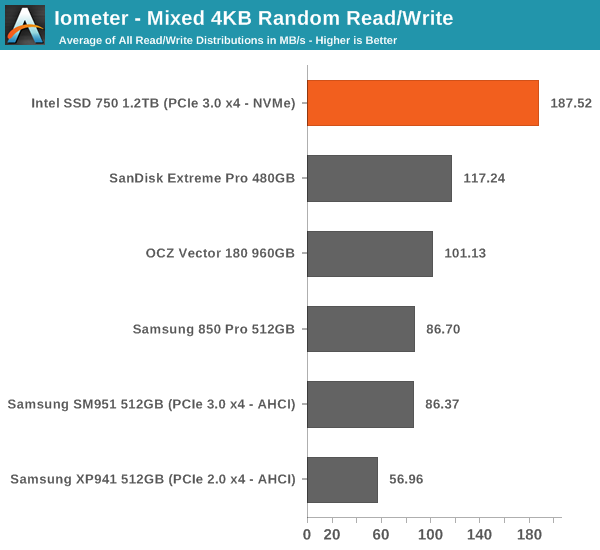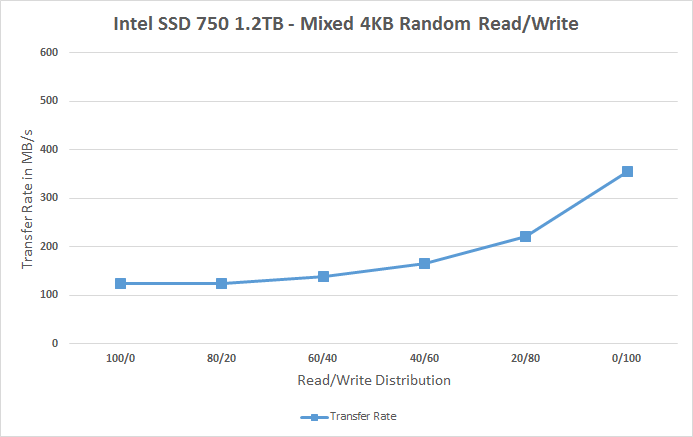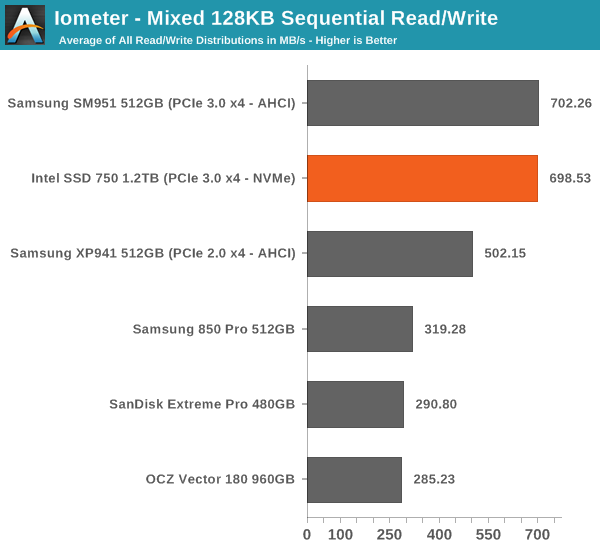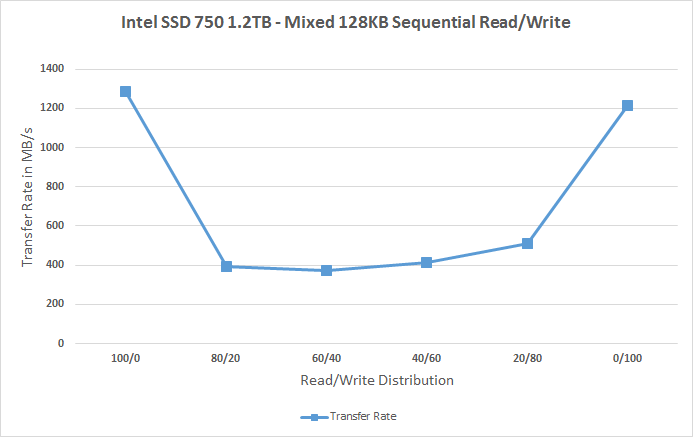Intel SSD 750 PCIe SSD Review: NVMe for the Client
by Kristian Vättö on April 2, 2015 12:00 PM ESTMixed Random Read/Write Performance
Mixed read/write tests are also a new addition to our test suite. In real world applications a significant portion of workloads are mixed, meaning that there are both read and write IOs. Our Storage Bench benchmarks already illustrate mixed workloads by being based on actual real world IO traces, but until now we haven't had a proper synthetic way to measure mixed performance.
The benchmark is divided into two tests. The first one tests mixed performance with 4KB random IOs at six different read/write distributions starting at 100% reads and adding 20% of writes in each phase. Because we are dealing with a mixed workload that contains reads, the drive is first filled with 128KB sequential data to ensure valid results. Similarly, because the IO pattern is random, I've limited the LBA span to 16GB to ensure that the results aren't affected by IO consistency. The queue depth of the 4KB random test is three.
Again, for the sake of readability, I provide both an average based bar graph as well as a line graph with the full data on it. The bar graph represents an average of all six read/write distribution data rates for quick comparison, whereas the line graph includes a separate data point for each tested distribution.

The SSD 750 does very well in mixed random workloads, especially when compared to the SM951 that is slower than most high-end SATA drives. The performance scales quite nicely as the portion of writes is increased.
 |
|||||||||
Mixed Sequential Read/Write Performance
The sequential mixed workload tests are also tested with a full drive, but I've not limited the LBA range as that's not needed with sequential data patterns. The queue depth for the tests is one.

In mixed sequential workloads, however, the SSD 750 and SM951 are practically indentical. Both deliver excellent performance at 100% reads and writes, but the performance does drop significantly once reads and writes are mixed. Even with the drop, the two push out 400MB/s whereas most SATA drives manage ~200MB/s, so PCIe certainly has a big advantage here.
 |
|||||||||










132 Comments
View All Comments
Per Hansson - Saturday, April 4, 2015 - link
It's most likely due to the poor performance of file transfers below 4KB with this drive.Shadowmaster625 - Thursday, April 2, 2015 - link
The funny thing is that the X25-M is STILL a great product. You can buy one on ebay and place it into a new build and it works just fine. And will continue to work just fine for many more years.eanazag - Thursday, April 2, 2015 - link
I have 4 X25-M 80 GB drives in RAID 0. The 750 is cheaper and faster than my setup. Price is based on what I paid several years ago for them.I would need a new motherboard and CPU to make this drive bootable. I do want.
Intel's PCIe lane bottleneck is pathetic. It seems to be a constant concern. X99 and Haswell-E is not the best answer to the problem. I am really skeptical about waiting for Skylake and the associated chipset. Broadwell for desktop hasn't even been released yet. Skylake for desktop will likely be next year at this rate.
DanNeely - Thursday, April 2, 2015 - link
Intel's never waivered from stating that SkyLake will launch on time and that all of the 14nm ramping delays will be absorbed by shortening broadwell's life. At this point I am wondering if desktop broadwell might end up being cut entirely in the mainstream market segment; with only the LGA2011 variant and possibly the LGA1150 celeron/pentium class chips that normally launch about a year after the rest of the product line on the desktop.r3loaded - Friday, April 3, 2015 - link
Skylake will bring 20 PCIe 3.0 lanes on the PCH, in addition to the PCIe 3.0 lanes coming off the CPU (Skylake-E CPUs will introduce PCIe 4.0) as well as support for up to three SATA Express/M.2 devices. Don't worry, Intel is well aware of the bandwidth bottleneck and they're addressing it.Hung_Low - Thursday, April 2, 2015 - link
So is thisi 750 the long rumoured P3500?Shadowmaster625 - Thursday, April 2, 2015 - link
I'm not satisfied with the explanations of why this product is slower than the SM951. By all rights it should be faster. Why would it still get a recommendation by anandtech?Kristian Vättö - Thursday, April 2, 2015 - link
It's only slower in the Heavy and Light traces, which focus more on peak performance rather than consistency. In The Destroyer trace the SSD 750 has significantly lower IO latency and that's what's critical for power users and professionals since it translates to more responsive system. The Heavy and Light traces don't really illustrate the workloads where the SSD 750 is aimed for, hence the SM951 is faster in those.BD2003 - Thursday, April 2, 2015 - link
Is it really measureably more responsive though? I guess I have a hard time believing that latencies measured in microseconds are going to bare out into any real world difference. Maybe it makes a difference on the single digit millisecond scale, but I'm talking real world here. Like is there any scenario where you'd be able to measure the *actual responsiveness*, meaning the time between clicking something and it actually responding to your command is measurably better? Even if it's just something minor like notepad opens in 50ms vs 100ms while you're compiling and backing up at the same time?Their target market is consumers so I feel like they've got to justify it on the basis of real world usage, not theory or benchmarks. From what I'm seeing here the SM951 looks like a better buy in every single way that matters.
SirPerro - Monday, April 6, 2015 - link
It's not about "clicking and responding". It's about different servers/databases handling hundreds of requests per second in a heavily multithreaded scenario.For UI interaction you probably cannot make the difference between this and the cheapest SSD on the market unless compared side by side.
As the review explains, this is targeted to a very specific niche. Whether people understand the scope of that niche or not is a different thing.